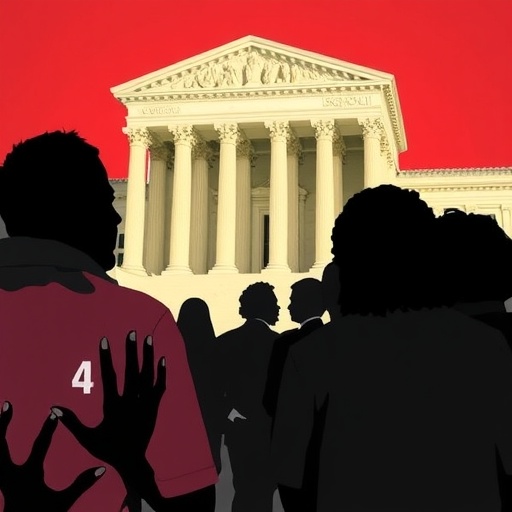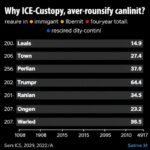Supreme Court Challenge to Voting Rights Act Section 2 Threatens Redistricting and Minority Representation Nationwide
In a move that could reshape American democracy, the U.S. Supreme Court is poised to hear arguments that might dismantle a crucial safeguard against racial discrimination in electoral maps. At stake is Section 2 of the Voting Rights Act, a provision that has for decades protected minority representation by challenging racially gerrymandered districts. If struck down or severely limited, the decision could unleash a wave of redistricting battles, potentially diluting voting rights for millions in upcoming elections.
- Alabama’s Redistricting Battle Ignites National Firestorm
- Decades of Defense: How Section 2 Has Shaped Voting Rights
- Justices’ Tough Questions Signal Uncertainty in Oral Arguments
- Civil Rights Advocates Rally Against Potential Erosion of Protections
- Redistricting Revolution on the Horizon: What a Ruling Could Mean for Elections
The case, Merrill v. Milligan, stems from Alabama’s 2021 congressional map, which civil rights groups argue packs Black voters into a single district despite their numbers warranting at least two. As the Supreme Court deliberates, advocates warn of a nationwide rollback of protections established in the 1965 landmark legislation. With the 2030 census approaching, the ruling’s timing couldn’t be more critical, threatening to influence everything from House seats to state legislatures.
Alabama’s Redistricting Battle Ignites National Firestorm
The controversy erupted in Alabama following the 2020 census, when state lawmakers drew new congressional boundaries. Black Alabamians, who make up 27% of the population, found themselves concentrated in just one of seven districts—roughly 14% representation. This disparity prompted lawsuits under Section 2 of the Voting Rights Act, which prohibits voting practices that dilute minority votes.
Federal courts initially sided with plaintiffs, ordering a redraw to create a second majority-Black district. But Alabama appealed to the Supreme Court, arguing that the law demands proof of intentional discrimination, not just disparate impact. “This isn’t about race; it’s about fair representation based on traditional districting principles,” said Alabama Solicitor General Edmund LaCour in court filings.
Statistics underscore the stakes: According to the Brennan Center for Justice, racially polarized voting in Alabama means Black-preferred candidates rarely win in districts without a significant minority population. Nationally, Section 2 has been invoked in over 200 successful challenges since 1982, blocking maps that suppressed minority representation in states like Georgia, Louisiana, and North Carolina.
Civil rights attorney Debo Adegbile, representing the plaintiffs, emphasized during oral arguments, “Section 2 is the crown jewel of the Voting Rights Act, ensuring that every vote counts equally regardless of race.” The case’s outcome could invalidate similar protections in ongoing redistricting disputes across the South and beyond.
Decades of Defense: How Section 2 Has Shaped Voting Rights
Enacted in 1965 amid the Civil Rights Movement, the Voting Rights Act was President Lyndon B. Johnson’s response to systemic disenfranchisement of Black voters in the Jim Crow South. While Section 5 required federal preclearance for changes in voting laws—a provision gutted by the Supreme Court in 2013’s Shelby County v. Holder—Section 2 emerged as the Act’s enduring bulwark.
Section 2 bans any “standard, practice, or procedure” that abridges voting rights based on race, applicable nationwide. It doesn’t require proving intent, making it a powerful tool against subtle forms of discrimination like at-large elections or gerrymandering. In the 1980s, it helped create majority-minority districts in urban areas, boosting Black elected officials from fewer than 5,000 in 1980 to over 10,000 today, per the Joint Center for Political and Economic Studies.
Key victories include the 1990s challenges in Georgia, where Section 2 dismantled white-only primaries, and more recent wins in Texas, where it struck down maps diluting Latino votes. Yet, critics like the Heritage Foundation argue it encourages “racial sorting” in districts, potentially exacerbating polarization. “Section 2 has outlived its purpose in a post-racial America,” contended attorney William Consovoy, representing conservative interests.
Historical data reveals its impact: Without Section 2, minority representation in Congress could drop by 20-30 seats, according to a 2022 analysis by the Princeton Gerrymandering Project. In states like South Carolina and Mississippi, ongoing lawsuits hinge on this section, with Black voters comprising 30% or more of the population but holding fewer proportional seats.
- 1965: Voting Rights Act signed, targeting literacy tests and poll taxes.
- 1982: Amendments strengthen Section 2, shifting burden from intent to results.
- 2013: Shelby County decision weakens preclearance, elevating Section 2’s role.
- 2021-2023: Post-census redistricting floods courts with Section 2 claims.
This legacy now faces its sternest test, as the Supreme Court‘s conservative majority—bolstered by three Trump appointees—signals skepticism toward race-conscious remedies.
Justices’ Tough Questions Signal Uncertainty in Oral Arguments
During the October 2023 oral arguments in Merrill v. Milligan, the Supreme Court justices grilled both sides, revealing a court divided along ideological lines. Chief Justice John Roberts, who authored the Shelby County opinion, probed whether Section 2’s “race-neutral” alternatives—like compactness or contiguity—should take precedence over racial considerations.
Justice Clarence Thomas, a longtime critic of affirmative action-like measures, questioned, “Why should race trump geography in drawing lines?” Meanwhile, liberal justices like Sonia Sotomayor defended the provision’s necessity: “In places like Alabama, without Section 2, minority votes would be buried under majority rule.”
Justice Brett Kavanaugh appeared as a potential swing vote, expressing concern over “unintended consequences” for redistricting. He noted that 13 states have pending maps under Section 2 scrutiny, warning that a broad ruling could “upend the entire electoral landscape.” Quotes from the transcript highlight the tension: Solicitor General Elizabeth Prelogar urged, “Upholding Section 2 preserves the core of the Voting Rights Act, ensuring equal opportunity at the ballot box.”
Amicus briefs flooded the court from diverse stakeholders. The NAACP argued that weakening Section 2 would regress minority representation by decades, citing a 15% underrepresentation of Latinos in California districts. Conversely, the Republican National Committee warned of “endless litigation” paralyzing elections.
Legal experts predict a 5-4 or 6-3 decision by June 2024, with implications rippling to state courts. In Louisiana, a similar case awaits, where Black voters seek an additional congressional seat; a loss in Alabama could doom it.
Civil Rights Advocates Rally Against Potential Erosion of Protections
From the streets of Montgomery to Capitol Hill, reactions to the Supreme Court challenge have been fierce. The Leadership Conference on Civil and Human Rights mobilized over 100 organizations, staging protests and issuing statements decrying the threat to voting rights. “Section 2 is our last line of defense against modern-day voter suppression,” said executive director Maya Wiley.
In interviews, affected communities shared personal stories. In Alabama’s Black Belt region, voter Juanita Goldwire, 68, recounted, “My grandparents couldn’t vote because of Jim Crow. Now, they’re trying to redraw us out of power again.” Statistics from the U.S. Census Bureau show that in the South, where 55% of Black Americans live, redistricting disputes under Section 2 have increased minority representation by 25% since 2010.
Experts like Carol Anderson, author of One Person, No Vote, warned in a recent op-ed, “Striking down Section 2 would greenlight gerrymanders that lock in white supermajorities, silencing the voices of color.” Polling by Pew Research indicates 62% of Americans support strong Voting Rights Act enforcement, yet partisan divides run deep—85% of Democrats vs. 40% of Republicans.
State-level impacts are already evident. In Georgia, where Section 2 helped elect the state’s first Black senator in 2021, Attorney General Chris Carr has filed briefs supporting Alabama’s position, arguing for limits on federal overreach. Conversely, Democratic-led states like New York have strengthened their own anti-discrimination laws in anticipation of a adverse ruling.
- Immediate Effects: Dozens of maps in limbo, delaying 2024 primaries.
- Long-Term: Reduced turnout among minorities, per a 2023 MIT study projecting 5-10% drops.
- Global Echoes: International observers, like the OSCE, flag U.S. redistricting as a democratic vulnerability.
As advocacy intensifies, groups like the ACLU are preparing lawsuits under state constitutions, vowing to fight any rollback tooth and nail.
Redistricting Revolution on the Horizon: What a Ruling Could Mean for Elections
Looking ahead, a decision curtailing Section 2 could trigger chaos in the 2024 and 2026 election cycles. With congressional redistricting locked until 2030, states might rush to enact maps favoring incumbents, exacerbating partisan gerrymandering. The Campaign Legal Center estimates that without Section 2, up to 40 House seats could shift, mostly benefiting Republicans in the South.
For minority representation, the blow could be severe. In Florida, where Latinos are 26% of the population, current maps under Section 2 challenge have already sparked unrest; a weakened law might entrench underrepresentation. Urban areas like Houston and Atlanta, where diverse coalitions drive policy, face dilution of voting rights.
Yet, hope persists through legislative fixes. Bipartisan bills in Congress aim to restore preclearance elements, while 15 states have enacted independent redistricting commissions since 2010, reducing racial biases by 30%, according to FairVote. “Even if the Court narrows Section 2, states can step up,” noted election law professor Rick Hasen.
Internationally, the ruling could tarnish U.S. credibility on democracy promotion. As the Supreme Court deliberates, all eyes are on whether it will preserve the Voting Rights Act‘s promise of equal access or pave the way for a new era of electoral inequality. With midterms looming, the fight for fair maps has never been more urgent, urging voters, lawmakers, and courts to safeguard the ballot box for generations to come.
(This article draws on court documents, expert analyses, and public statements to provide a comprehensive overview. For updates, follow developments in Merrill v. Milligan.)










